Impact Response and Damage Tolerance of Hybrid Glass/Kevlar-Fibre Epoxy Structural Composites
Abstract
:1. Introduction
- One material sandwiched by two layers of others;
- Alternate and mixed stacking sequences of two or more layers with different fibres;
- Reinforcement of two different short fibres/continuous fibres or short fibre with continuous fibre;
- Reinforcement of particles or other constituents to the aforementioned combinations.
2. Materials and Methods
2.1. Experimental Setup Facility
2.1.1. Tensile, Flexural, and Impact Strength
2.1.2. Interlaminar Shear Strength (ILSS)
2.1.3. High-Velocity Impact Test
3. Results and Discussion
3.1. Tensile, Flexural, Impact and ILSS Properties
3.2. High-Velocity Impact Test Results
4. Conclusions
- The maximum tensile strength (ca. 232 MPa) of the composites was noted on the composite with 45° fibre orientation (ca. 2.6% and ca. 4.7% higher than 0° and 45° fibre orientations, respectively) and maximum failure strain (ca. 1.3%) was obtained on the 0° fibre orientated composite. The maximum tensile modulus of ca. 26 GPa was noted on the 60° fibre orientated composite.
- The flexural properties of the composite were high for the 0° fibre orientated composite when compared to 45° (ca. 10.9%) and 60° (ca. 2.5%) fibre orientated composites. The maximum strength, failure strain and modulus were ca. 321 MPa. 18% and 12 GPa, respectively.
- Compared to the Izod impact strength, Charpy impact strength showed the maximum strength. The maximum Charpy impact strength (ca. 105 kJ/m2) was noted for 45° fibre-oriented composite, whereas the maximum Izod impact strength (ca. 70 kJ/m2) was noted for 0° fibre-oriented composite.
- The maximum interlaminar shear strength of ca. 27 MPa was observed on the 0° fibre-oriented composite and minimum (ca. 20 MPa) was noted on the 60° fibre-oriented composite.
- In the high-velocity impact test, 45° fibre-oriented composite showed better results. The energy absorbed by the composite was ca. 58 J (ca. 23.7% > 0° orientation and ca. 36.8% > 60° orientation, of the Kevlar layers) and the velocity drop was ca. 62 m/s, which was again ca. 28.3% and ca. 42.2% higher than the samples having 0° and 45° fibre orientations, respectively. The residual velocity of the 45° fibre-oriented composite was ca. 108 m/s, being ca. 13.9% and ca. 19.5% lower than those oriented at 0° and 60°, respectively.
Author Contributions
Funding
Institutional Review Board Statement
Informed Consent Statement
Data Availability Statement
Acknowledgments
Conflicts of Interest
References
- Vigneshwaran, S.; Sundarakannan, R.; John, K.M.; Joel Johnson, R.D.; Prasath, K.A.; Ajith, S.; Arumugaprabu, V.; Uthayakumar, M. Recent advancement in the natural fiber polymer composites: A comprehensive review. J. Clean. Prod. 2020, 277, 124109. [Google Scholar] [CrossRef]
- Sadighi, M.; Alderliesten, R.C.; Benedictus, R. Impact resistance of fiber-metal laminates: A review. Int. J. Impact Eng. 2012, 49, 77–90. [Google Scholar] [CrossRef]
- Safri, S.N.A.; Sultan, M.T.H.; Jawaid, M.; Jayakrishna, K. Impact behaviour of hybrid composites for structural applications: A review. Compos. Part B Eng. 2018, 133, 112–121. [Google Scholar] [CrossRef]
- Shah, S.Z.H.; Karuppanan, S.; Megat-Yusoff, P.S.M.; Sajid, Z. Impact resistance and damage tolerance of fiber reinforced composites: A review. Compos. Struct. 2019, 217, 100–121. [Google Scholar] [CrossRef]
- Retnam, B.S.; Sivapragash, M.; Pradeep, P. Effects of fibre orientation on mechanical properties of hybrid bamboo/glass fibre polymer composites. Bull. Mater. Sci. 2014, 37, 1059–1064. [Google Scholar] [CrossRef]
- Pickering, K.L.; Efendy, M.G.A.; Le, T.M. A review of recent developments in natural fibre composites and their mechanical performance. Compos. Part A Appl. Sci. Manuf. 2016, 83, 98–112. [Google Scholar] [CrossRef] [Green Version]
- Saba, N.; Jawaid, M.; Alothman, O.Y.; Paridah, M.T. A review on dynamic mechanical properties of natural fibre reinforced polymer composites. Constr. Build. Mater. 2016, 106, 149–159. [Google Scholar] [CrossRef]
- Wang, Y.; Xia, Y.M. Experimental and theoretical study on the strain rate and temperature dependence of mechanical behaviour of Kevlar fibre. Compos. Part A Appl. Sci. Manuf. 1999, 30, 1251–1257. [Google Scholar] [CrossRef]
- Berthelot, J.M.; Sefrani, Y. Damping analysis of unidirectional glass and Kevlar fibre composites. Compos. Sci. Technol. 2004, 64, 1261–1278. [Google Scholar] [CrossRef]
- Das, S. The Cost of Automotive Polymer Composites: A Review and Assessment of DOE’s Lightweight Materials Composites Research; Oak Ridge National Laboratory: Oak Ridge, TN, USA, 2001. [Google Scholar]
- McConnell, T.E.; da Silva, B.K.; Sun, C.; Tanger, S.M. Forest to Mill Timber Price Trends and Volatility for Mississippi Timber Products. For. Prod. J. 2021, 71, 177–187. [Google Scholar] [CrossRef]
- Khan, Z.I.; Arsad, A.; Mohamad, Z.; Habib, U.; Zaini, M.A.A. Comparative study on the enhancement of thermo-mechanical properties of carbon fiber and glass fiber reinforced epoxy composites. Mater. Today: Proc. 2021, 39, 956–958. [Google Scholar] [CrossRef]
- Chanda, A.; Bhattacharyya, D. A parametric study to minimise spring-back while producing plywood channels. J. Clean. Prod. 2021, 304, 127109. [Google Scholar] [CrossRef]
- Suresh Kumar, C.; Arumugam, V.; Dhakal, H.N.; John, R. Effect of temperature and hybridisation on the low velocity impact behavior of hemp-basalt/epoxy composites. Compos. Struct. 2015, 125, 407–416. [Google Scholar] [CrossRef]
- Swolfs, Y.; McMeeking, R.M.; Rajan, V.P.; Zok, F.W.; Verpoest, I.; Gorbatikh, L. Global load-sharing model for unidirectional hybrid fibre-reinforced composites. J. Mech. Phys. Solids 2015, 84, 380–394. [Google Scholar] [CrossRef] [Green Version]
- Bulut, M.; Erkliğ, A.; Yeter, E. Experimental investigation on influence of Kevlar fiber hybridization on tensile and damping response of Kevlar/glass/epoxy resin composite laminates. J. Compos. Mater. 2015, 50, 1875–1886. [Google Scholar] [CrossRef]
- Hosur, M.V.; Adbullah, M.; Jeelani, S. Studies on the low-velocity impact response of woven hybrid composites. Compos. Struct. 2005, 67, 253–262. [Google Scholar] [CrossRef]
- Chen, D.; Luo, Q.; Meng, M.; Sun, G. Low velocity impact behavior of interlayer hybrid composite laminates with carbon/glass/basalt fibres. Compos. Part B Eng. 2019, 176, 107191. [Google Scholar] [CrossRef]
- Pandya, K.S.; Pothnis, J.R.; Ravikumar, G.; Naik, N.K. Ballistic impact behavior of hybrid composites. Mater. Des. 2013, 44, 128–135. [Google Scholar] [CrossRef]
- Gustin, J.; Joneson, A.; Mahinfalah, M.; Stone, J. Low velocity impact of combination Kevlar/carbon fiber sandwich composites. Compos. Struct. 2005, 69, 396–406. [Google Scholar] [CrossRef]
- Valenҫa, S.L.; Griza, S.; De Oliveira, V.G.; Sussuchi, E.M.; De Cunha, F.G.C. Evaluation of the mechanical behavior of epoxy composite reinforced with Kevlar plain fabric and glass/Kevlar hybrid fabric. Compos. Part B Eng. 2015, 70, 1–8. [Google Scholar] [CrossRef]
- Naik, N.K.; Shrirao, P. Composite structures under ballistic impact. Compos. Struct. 2004, 66, 579–590. [Google Scholar] [CrossRef]
- Vasudevan, A.; Kumaran, S.S.; Naresh, K.; Velmurugan, R. Layer-wise damage prediction in carbon/Kevlar/S-glass/E-glass fibre reinforced epoxy hybrid composites under low-velocity impact loading using advanced 3D computed tomography. Int. J. Crashworthiness 2019, 25, 9–23. [Google Scholar] [CrossRef]
- Vasudevan, A.; Kumaran, S.S.; Naresh, K.; Velmurugan, R.; Shankar, K. Advanced 3D and 2D damage assessment of low velocity impact response of glass and Kevlar fiber reinforced epoxy hybrid composites. Adv. Mater. Process. Technol. 2018, 4, 493–510. [Google Scholar] [CrossRef]
- Matykiewicz, D.; Barczewski, M. On the impact of flax fibers as an internal layer on the properties of basalt-epoxy composites modified with silanized basalt powder. Compos. Commun. 2020, 20, 100360. [Google Scholar] [CrossRef]
- Zhang, J.; Chaisombat, K.; He, S.; Wang, C.H. Hybrid composite laminates reinforced with glass/carbon woven fabrics for lightweight load bearing structures. Mater. Des. 2012, 36, 75–80. [Google Scholar] [CrossRef]
- Chanda, A.; Kim, N.K.; Bhattacharyya, D. Manufacturing and characterisation of wood-veneer sandwich panels with flame-retardant composite cores. Compos. Commun. 2021, 1, 100870. [Google Scholar] [CrossRef]
- Fazal, A.; Fancey, K.S. Performance enhancement of nylon/kevlar fiber composites through viscoelastically generated pre-stress. Polym. Compos. 2014, 35, 931–938. [Google Scholar] [CrossRef] [Green Version]
- Murugan, P.; Naresh, K.; Shankar, K.; Velmurugan, R.; Balaganesan, G. High velocity impact damage investigation of carbon/epoxy/clay nanocomposites using 3D Computed Tomography. Mater. Today Proc. 2018, 5, 16946–16955. [Google Scholar] [CrossRef]

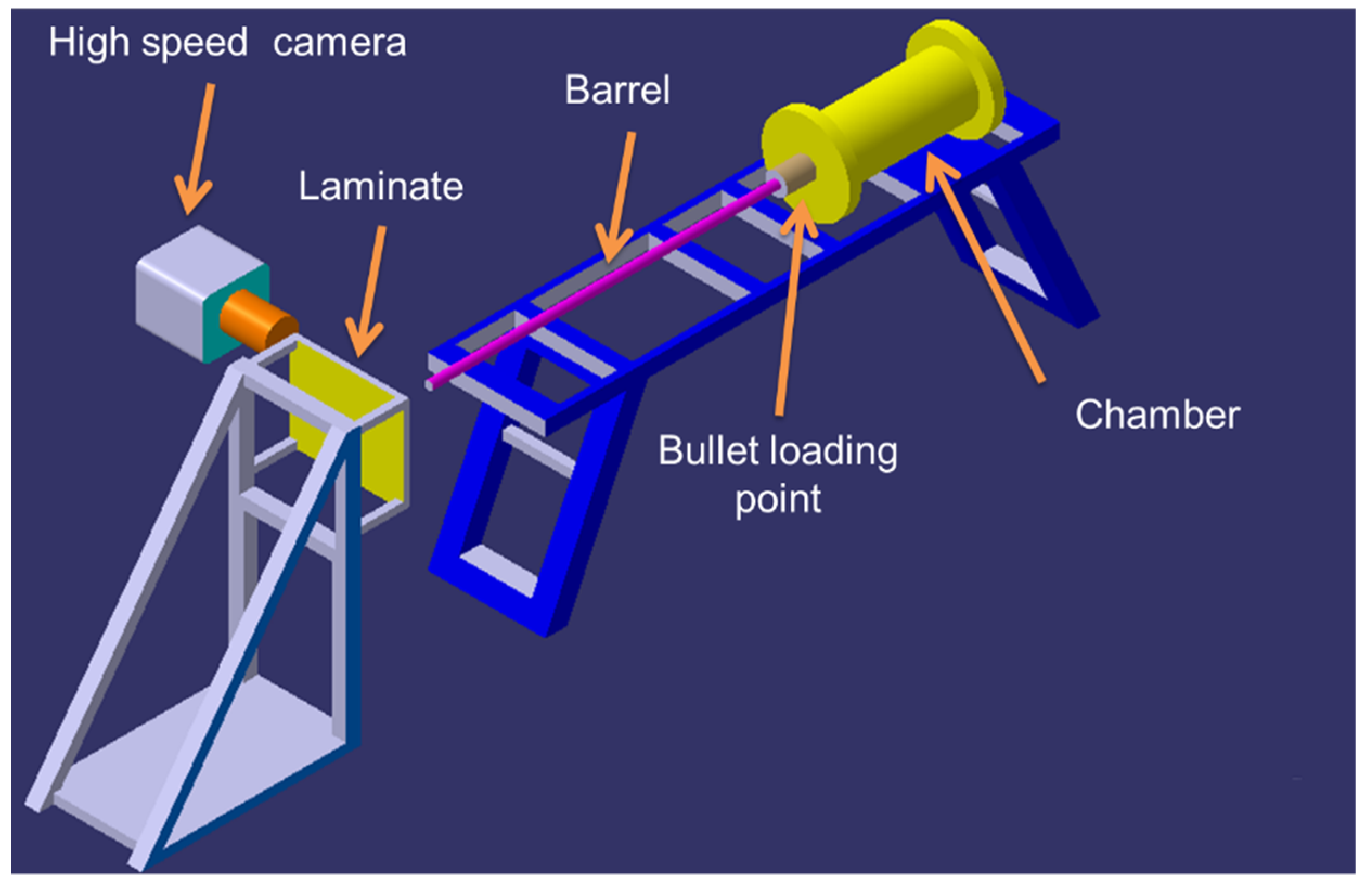
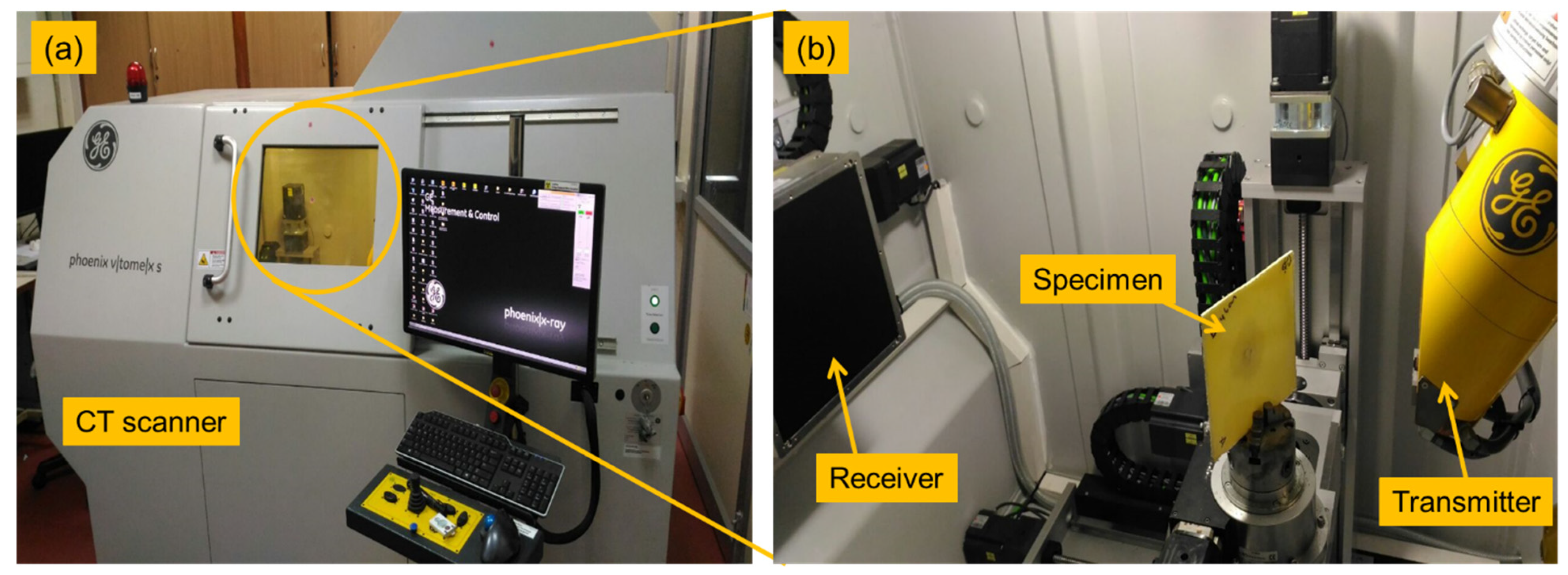

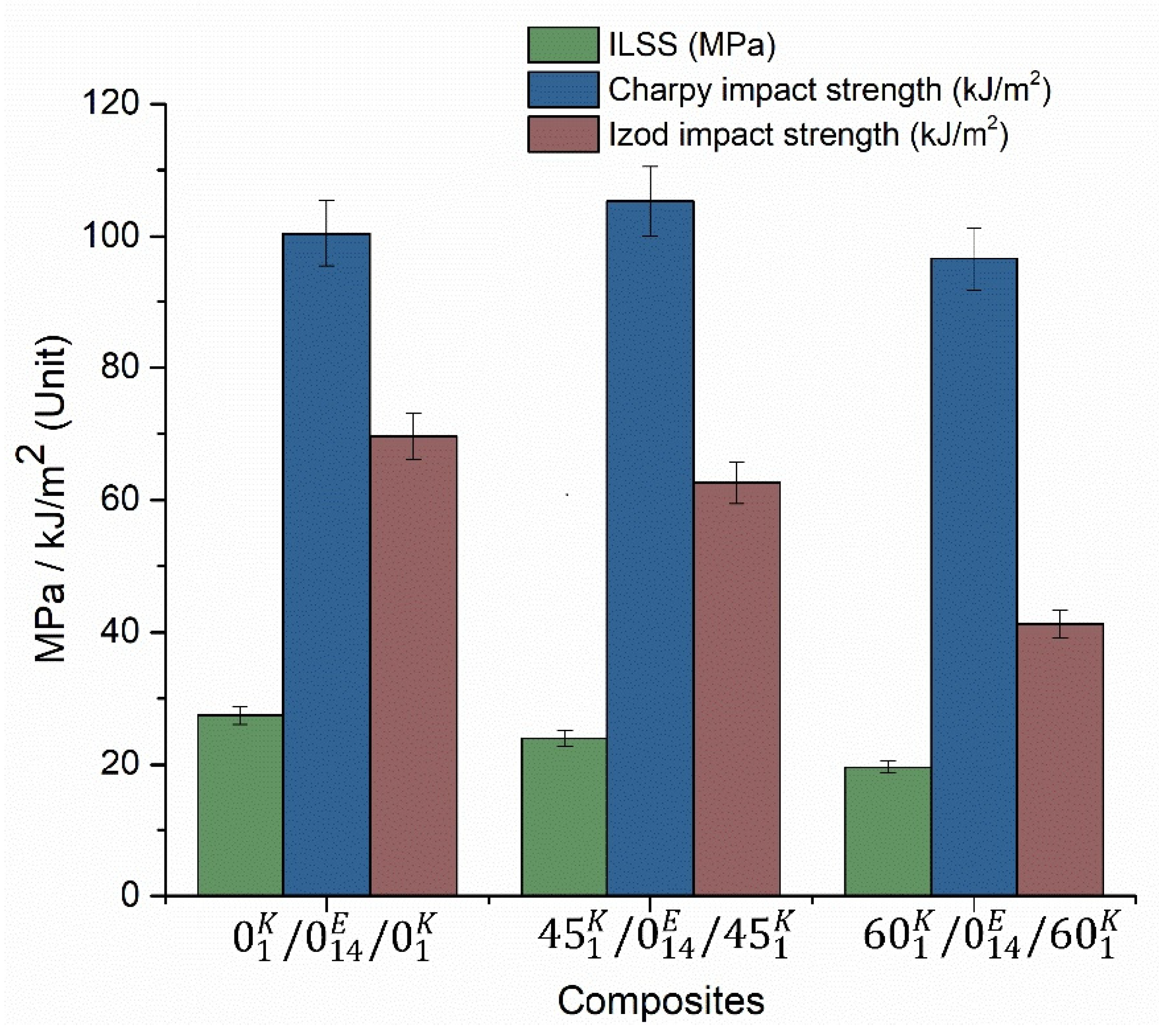
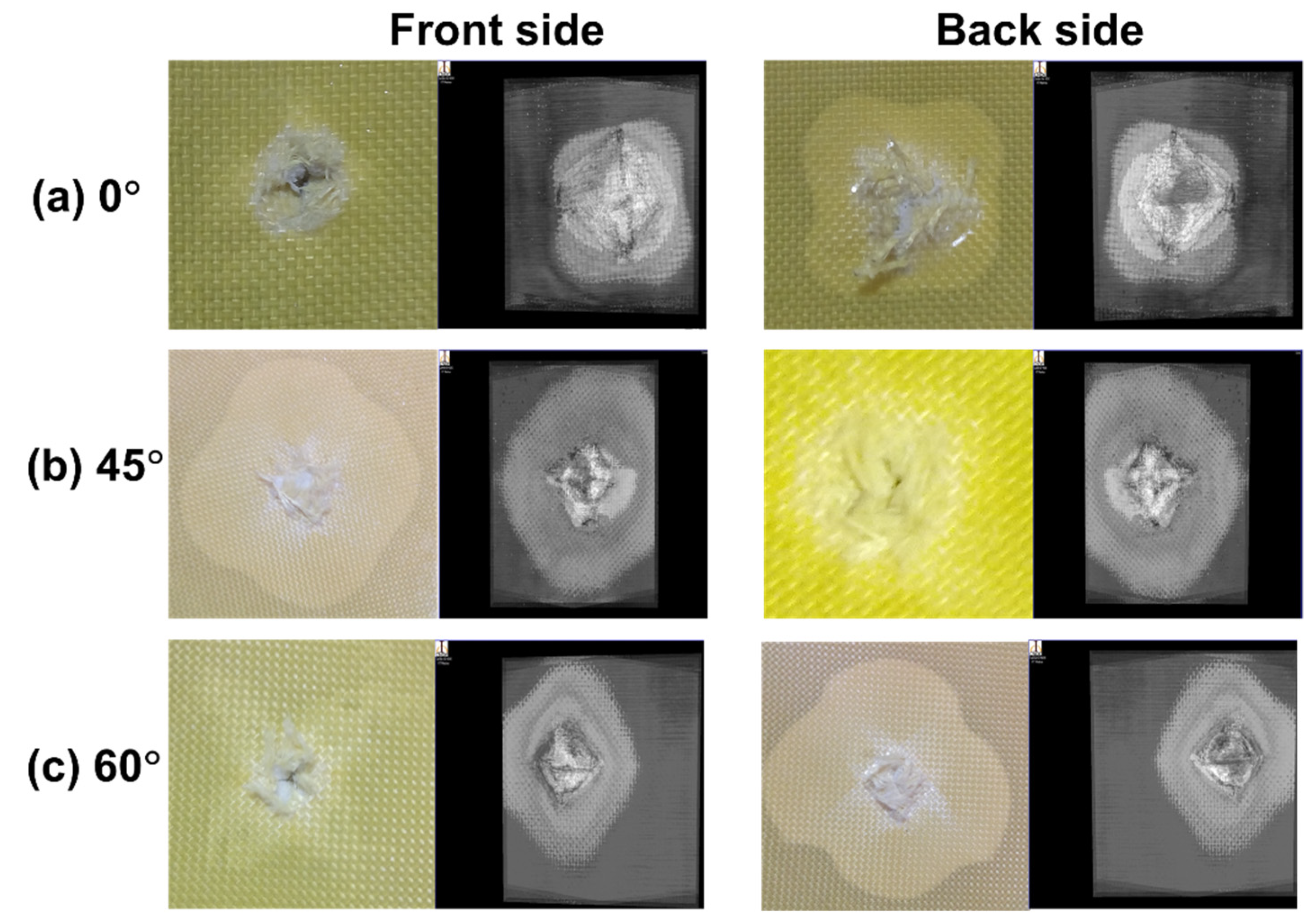
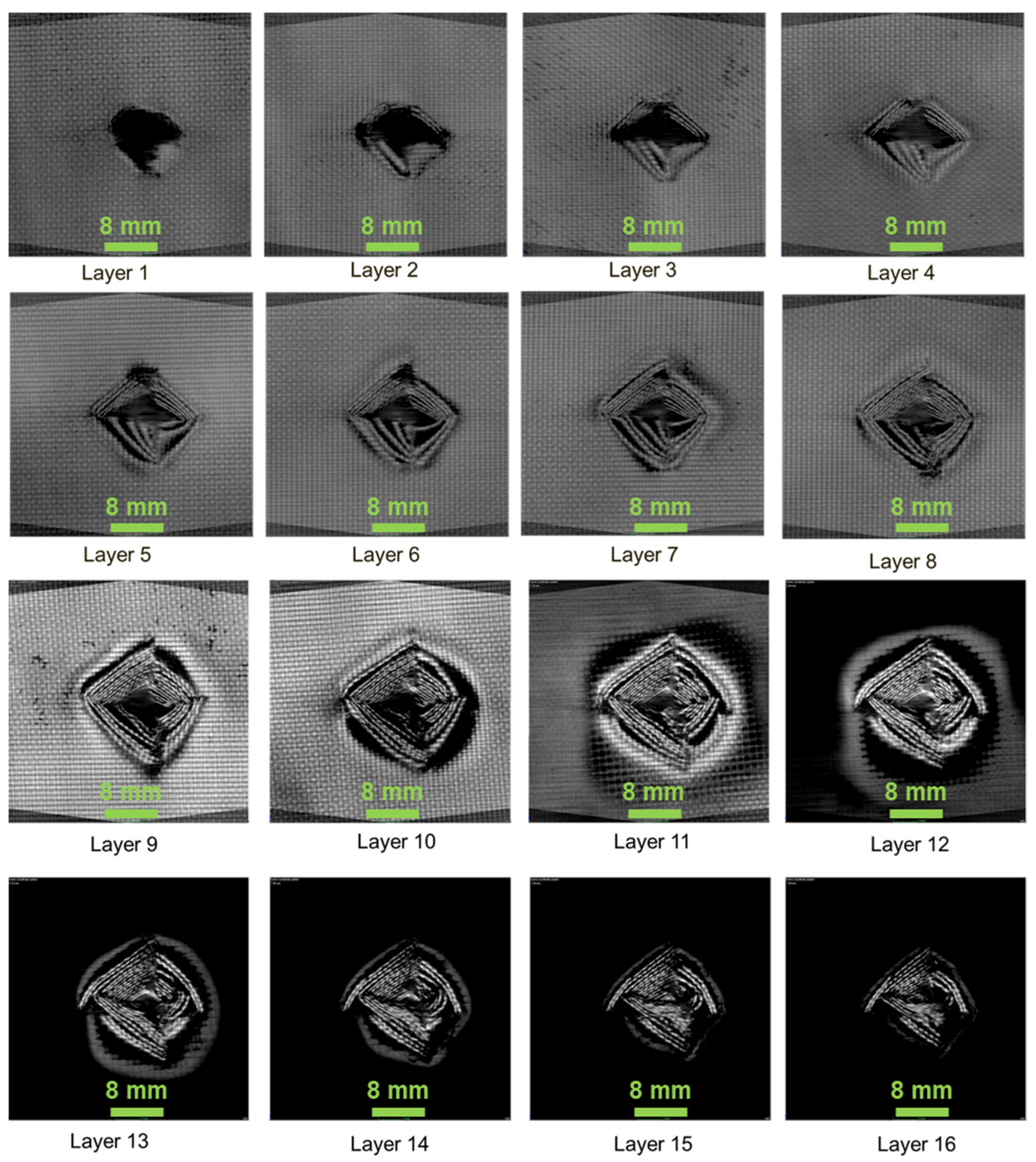
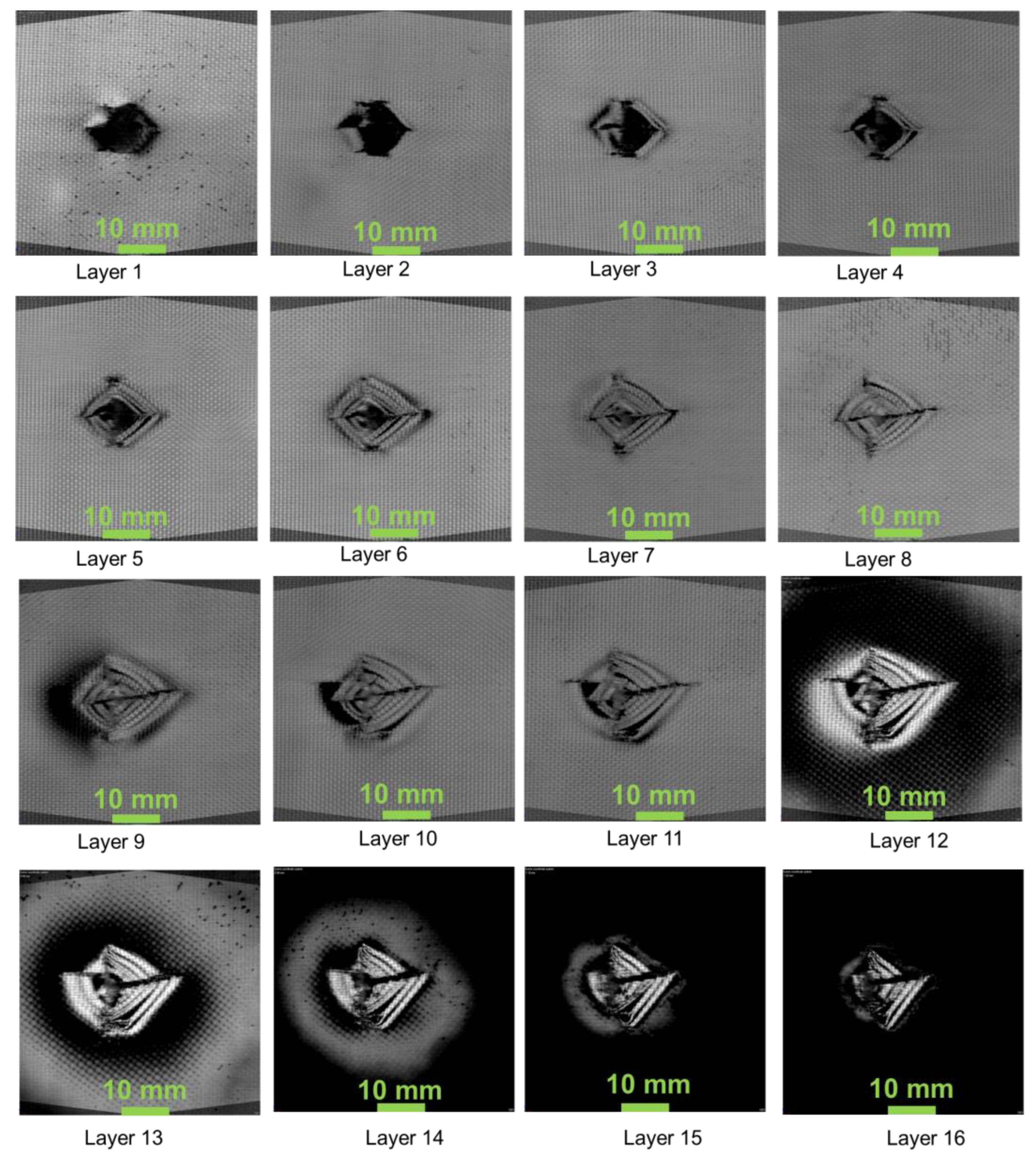
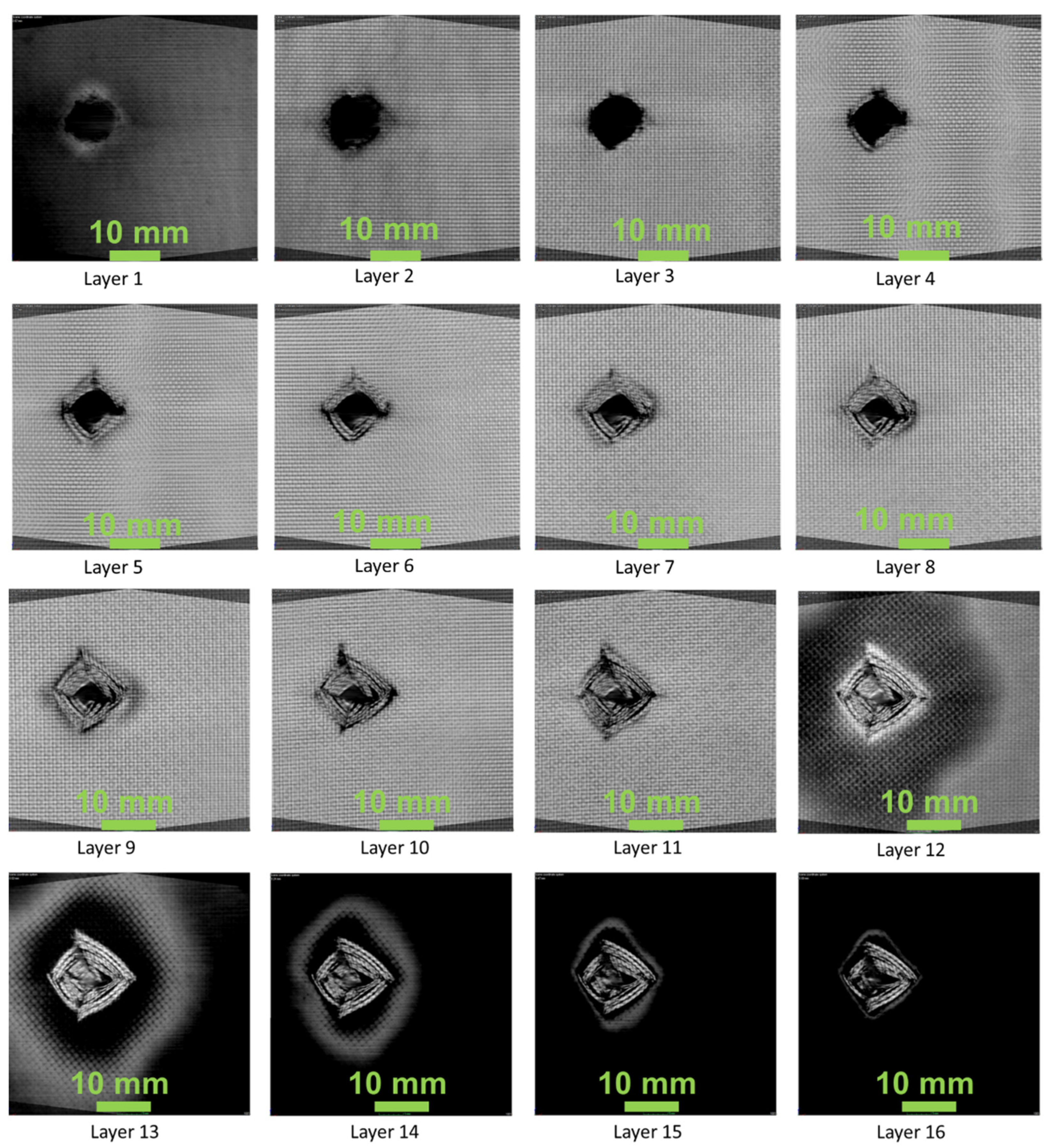
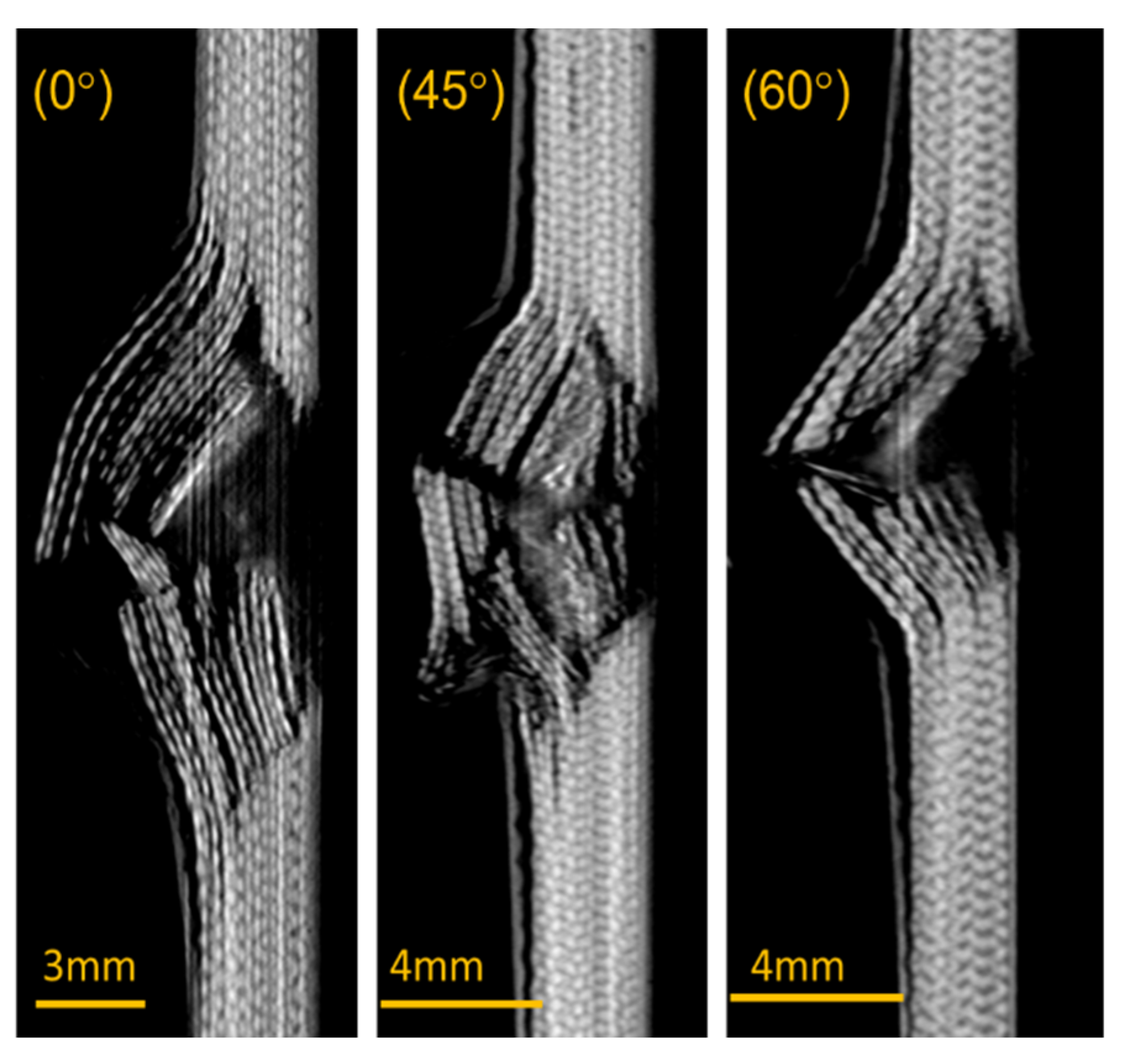
| Specimen Name | Top Layer | Middle Layers | Bottom Layers | Ply Orientation | Total No. of Ply | Total Thickness, mm | |||
|---|---|---|---|---|---|---|---|---|---|
| Fibre | No. of Ply | Fibre | No. of Ply | Fibre | No. of Ply | ||||
| [01k/014E/01k] | Kevlar | 1 | E- Glass | 14 | Kevlar | 1 | 0/0/0 | 16 | 3 |
| [451k/014E/451k] | Kevlar | 1 | E- Glass | 14 | Kevlar | 1 | 45/0/45 | 16 | 3 |
| [601k/014E/601k] | Kevlar | 1 | E- Glass | 14 | Kevlar | 1 | 60/0/60 | 16 | 3 |
| Material | Tensile Strength (MPa) | Failure Strain (%) | Tensile Modulus (GPa) |
|---|---|---|---|
| [01k/014E/01k] | 226 * ± 2.3 | 1.3 * ± 0.1 | 17 * ± 0.5 |
| [451k/014E/451k] | 232 ** ± 3.0 | 1.2 ** ± 0.12 | 21 ± 1.35 |
| [601k/014E/601k] | 221 ** ± 1.3 | 0.8 ** ± 0.09 | 26 ± 0.3 |
| Material | Flexural Strength (MPa) | Failure Strain (%) | Flexural Modulus (GPa) |
|---|---|---|---|
| [01k/014E/01k] | 321 * ± 1.13 | 18 * ± 0.9 | 12 * ± 0.5 |
| [451k/014E/451k] | 286 ** ± 2.6 | 15 ** ± 1.06 | 12 ± 1.2 |
| [601k/014E/601k] | 313 ** ± 1.6 | 12.6 ** ± 1.5 | 10.5 ± 0.9 |
| Sample | Initial Velocity (m/s) Vi | Residual Velocity (m/s) Vr | Velocity Drop (m/s) Vd | Energy Absorption Composite (J) Ecp |
|---|---|---|---|---|
| [01k/014E/01k] | 170 | 125.3 | 44.5 | 44.8 |
| [451k/014E/451k] | 170 | 107.9 | 62.1 | 58.7 |
| [601k/014E/601k] | 170 | 134.08 | 35.9 | 37.1 |
Publisher’s Note: MDPI stays neutral with regard to jurisdictional claims in published maps and institutional affiliations. |
© 2021 by the authors. Licensee MDPI, Basel, Switzerland. This article is an open access article distributed under the terms and conditions of the Creative Commons Attribution (CC BY) license (https://creativecommons.org/licenses/by/4.0/).
Share and Cite
Alagumalai, V.; Shanmugam, V.; Balasubramanian, N.K.; Krishnamoorthy, Y.; Ganesan, V.; Försth, M.; Sas, G.; Berto, F.; Chanda, A.; Das, O. Impact Response and Damage Tolerance of Hybrid Glass/Kevlar-Fibre Epoxy Structural Composites. Polymers 2021, 13, 2591. https://doi.org/10.3390/polym13162591
Alagumalai V, Shanmugam V, Balasubramanian NK, Krishnamoorthy Y, Ganesan V, Försth M, Sas G, Berto F, Chanda A, Das O. Impact Response and Damage Tolerance of Hybrid Glass/Kevlar-Fibre Epoxy Structural Composites. Polymers. 2021; 13(16):2591. https://doi.org/10.3390/polym13162591
Chicago/Turabian StyleAlagumalai, Vasudevan, Vigneshwaran Shanmugam, Navin Kumar Balasubramanian, Yoganandam Krishnamoorthy, Velmurugan Ganesan, Michael Försth, Gabriel Sas, Filippo Berto, Avishek Chanda, and Oisik Das. 2021. "Impact Response and Damage Tolerance of Hybrid Glass/Kevlar-Fibre Epoxy Structural Composites" Polymers 13, no. 16: 2591. https://doi.org/10.3390/polym13162591
APA StyleAlagumalai, V., Shanmugam, V., Balasubramanian, N. K., Krishnamoorthy, Y., Ganesan, V., Försth, M., Sas, G., Berto, F., Chanda, A., & Das, O. (2021). Impact Response and Damage Tolerance of Hybrid Glass/Kevlar-Fibre Epoxy Structural Composites. Polymers, 13(16), 2591. https://doi.org/10.3390/polym13162591











